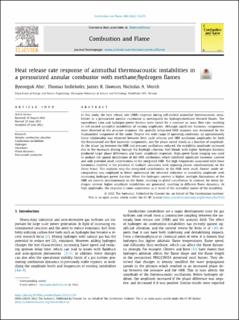| dc.contributor.author | Ahn, Byeonguk | |
| dc.contributor.author | Indlekofer, Thomas | |
| dc.contributor.author | Dawson, James | |
| dc.contributor.author | Worth, Nicholas | |
| dc.date.accessioned | 2023-01-09T10:12:17Z | |
| dc.date.available | 2023-01-09T10:12:17Z | |
| dc.date.created | 2022-08-10T15:28:37Z | |
| dc.date.issued | 2022 | |
| dc.identifier.citation | Combustion and Flame. 2022, 244 112274-?. | en_US |
| dc.identifier.issn | 0010-2180 | |
| dc.identifier.uri | https://hdl.handle.net/11250/3041876 | |
| dc.description.abstract | In this study, the heat release rate (HRR) response during self-excited azimuthal thermoacoustic instabilities in a pressurized annular combustor is investigated for hydrogen/methane blended flames. The equivalence ratio and hydrogen power fraction were varied for a constant air mass flow rate, resulting in self-excited azimuthal instabilities of varying amplitudes. Although significant harmonic components were observed in the pressure response, the spatially integrated HRR response was dominated by the fundamental component of the mode. Despite the wide range of operating conditions, an approximately linear relationship was observed between limit cycle velocity and HRR oscillation amplitudes for both the fundamental and first harmonic components, and the phase varied slowly as a function of amplitude. As the phase lag between the HRR and pressure oscillations reduced, the instability amplitude increased due to the increased driving through the Rayleigh criterion. Fuel blends with higher hydrogen fractions produced larger phase differences and lower amplitude responses. High-speed flame imaging was used to analyze the spatial distribution of the HRR oscillations which exhibited significant harmonic content and only provided small contributions to the integrated HRR. The high frequencies associated with these harmonics resulted in the presence of multiple structures with opposing phases simultaneously on the flame brush. This explains why the integrated contributions to the HRR were small. Fourier mode decomposition was employed to better understand the observed reduction in instability amplitude with increasing hydrogen power fraction. When the hydrogen content is higher, multiple fluctuations of the HRR are present simultaneously on the flame, resulting in global cancellation. In contrast, for lower hydrogen content, higher amplitude instabilities are generated, resulting in different flame dynamics. At high amplitudes, the response is more asymmetric as a result of the azimuthal nature of the instability. | en_US |
| dc.language.iso | eng | en_US |
| dc.publisher | Elsevier | en_US |
| dc.rights | Navngivelse 4.0 Internasjonal | * |
| dc.rights.uri | http://creativecommons.org/licenses/by/4.0/deed.no | * |
| dc.title | Heat release rate response of azimuthal thermoacoustic instabilities in a pressurized annular combustor with methane/hydrogen flames | en_US |
| dc.title.alternative | Heat release rate response of azimuthal thermoacoustic instabilities in a pressurized annular combustor with methane/hydrogen flames | en_US |
| dc.type | Journal article | en_US |
| dc.type | Peer reviewed | en_US |
| dc.description.version | publishedVersion | en_US |
| dc.source.pagenumber | 112274-? | en_US |
| dc.source.volume | 244 | en_US |
| dc.source.journal | Combustion and Flame | en_US |
| dc.identifier.doi | 10.1016/j.combustflame.2022.112274 | |
| dc.identifier.cristin | 2042274 | |
| cristin.ispublished | true | |
| cristin.fulltext | original | |
| cristin.qualitycode | 2 | |

